-

新人教版高中英语选修2Unit 1 Science and Scientists-Reading and thinking教学设计
Step 5: After learning the text, discuss with your peers about the following questions:1.John Snow believed Idea 2 was right. How did he finally prove it?2. Do you think John Snow would have solved this problem without the map?3. Cholera is a 19th century disease. What disease do you think is similar to cholera today?SARS and Covid-19 because they are both deadly and fatally infectious, have an unknown cause and need serious public health care to solve them urgently.keys:1. John Snow finally proved his idea because he found an outbreak that was clearly related to cholera, collected information and was able to tie cases outside the area to the polluted water.2. No. The map helped John Snow organize his ideas. He was able to identify those households that had had many deaths and check their water-drinking habits. He identified those houses that had had no deaths and surveyed their drinking habits. The evidence clearly pointed to the polluted water being the cause.3. SARS and Covid-19 because they are both deadly and fatally infectious, have an unknown cause and need serious public health care to solve them urgently.Step 6: Consolidate what you have learned by filling in the blanks:John Snow was a well-known _1___ in London in the _2__ century. He wanted to find the _3_____ of cholera in order to help people ___4_____ it. In 1854 when a cholera __5__ London, he began to gather information. He ___6__ on a map ___7___ all the dead people had lived and he found that many people who had ___8____ (drink) the dirty water from the __9____ died. So he decided that the polluted water ___10____ cholera. He suggested that the ___11__ of all water supplies should be _12______ and new methods of dealing with ____13___ water be found. Finally, “King Cholera” was __14_____.Keys: 1. doctor 2. 19th 3.cause 4.infected with 5.hit 6.marked 7.where 8.drunk 9.pump 10.carried 11.source 12.examined 13.polluted 14.defeatedHomework: Retell the text after class and preview its language points

新人教版高中英语选修2Unit 1 Science and Scientists-Using langauge教学设计
This happens because the dish soap molecules have a strong negative charge, and the milk molecules have a strong positive charge. Like magnets, these molecules are attracted to each other, and so they appear to move around on the plate, taking the food coloring with them, making it look like the colors are quickly moving to escape from the soap.Listening text:? Judy: Oh, I'm so sorry that you were ill and couldn't come with us on our field trip. How are you feeling now? Better?? Bill: Much better, thanks. But how was it?? Judy: Wonderful! I especially liked an area of the museum called Light Games.it was really cool. They had a hall of mirrors where I could see myself reflected thousands of times!? Bill: A hall of mirrors can be a lot of fun. What else did they have?? Judy: Well, they had an experiment where we looked at a blue screen for a while, and then suddenly we could see tiny bright lights moving around on it. You'll never guess what those bright lights were!? Bill: Come on, tell me!? Judy: They were our own blood cells. For some reason, our eyes play tricks on us when we look at a blue screen, and we can see our own blood cells moving around like little lights! But there was another thing I liked better. I stood in front of a white light, and it cast different shadows of me in every color of the rainbow!? Bill: Oh, I wish I had been there. Tell me more!? Judy: Well, they had another area for sound. They had a giant piano keyboard that you could use your feet to play. But then, instead of playing the sounds of a piano, it played the voices of classical singers! Then they had a giant dish, and when you spoke into it, it reflected the sound back and made it louder. You could use it to speak in a whisper to someone 17 meters away.? Bill: It all sounds so cool. I wish I could have gone with you? Judy: I know, but we can go together this weekend. I'd love to go there again!? Bill: That sounds like a great idea!

新人教版高中英语选修2Unit 3 Food and Culture-Discovering useful structures教学设计
The newspaper reported more than 100 people had been killed in the thunderstorm.报纸报道说有一百多人在暴风雨中丧生。(2)before、when、by the time、until、after、once等引导的时间状语从句的谓语是一般过去时,以及by、before后面接过去的时间时,主句动作发生在从句的动作或过去的时间之前且表示被动时,要用过去完成时的被动语态。By the time my brother was 10, he had been sent to Italy.我弟弟10岁前就已经被送到意大利了。Tons of rice had been produced by the end of last month. 到上月底已生产了好几吨大米。(3) It was the first/second/last ... time that ...句中that引导的定语从句中,主语与谓语构成被动关系时,要用过去完成时的被动语态。It was the first time that I had seen the night fact to face in one and a half years. 这是我一年半以来第一次亲眼目睹夜晚的景色。(4)在虚拟语气中,条件句表示与过去事实相反,且主语与谓语构成被动关系时,要用过去完成时的被动语态。If I had been instructed by him earlier, I would have finished the task.如果我早一点得到他的指示,我早就完成这项任务了。If I had hurried, I wouldn't have missed the train.如果我快点的话,我就不会误了火车。If you had been at the party, you would have met him. 如果你去了晚会,你就会见到他的。

新人教版高中英语选修2Unit 3 Food and Culture-Reading and thinking教学设计
The discourse explores the link between food and culture from a foreign’s perspective and it records some authentic Chinese food and illustrates the cultural meaning, gerography features and historic tradition that the food reflects. It is aimed to lead students to understand and think about the connection between food and culture. While teaching, the teacher should instruct students to find out the writing order and the writer’s experieces and feelings towards Chinese food and culture.1.Guide the students to read the text, sort out the information and dig out the topic.2.Understand the cultural connotation, regional characteristics and historical tradition of Chinese cuisine3.Understand and explore the relationship between food and people's personality4.Guide the students to use the cohesive words in the text5.Lead students to accurately grasp the real meaning of the information and improve the overall understanding ability by understanding the implied meaning behind the text.1. Enable the Ss to understand the structure and the writing style of the passage well.2. Lead the Ss to understand and think further about the connection between food and geography and local character traits.Step1: Prediction before reading. Before you read, look at the title, and the picture. What do you think this article is about?keys:It is about various culture and cuisine about a place or some countries.
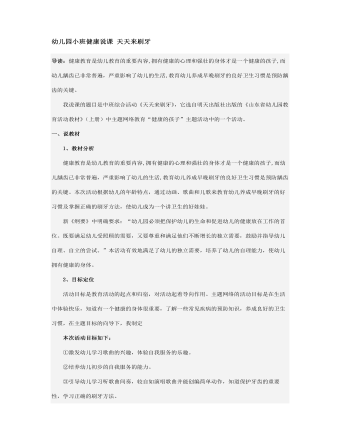
幼儿园小班健康说课 天天来刷牙
1、教材分析 健康教育是幼儿教育的重要内容,拥有健康的心理和强壮的身体才是一个健康的孩子,而幼儿龋齿已非常普遍,严重影响了幼儿的生活,教育幼儿养成早晚刷牙的良好卫生习惯是预防龋齿的关键。本次活动根据幼儿的年龄特点,通过动画、歌曲和儿歌来教育幼儿养成早晚刷牙的好习惯及掌握正确的刷牙方法,使幼儿成为一个讲卫生的好娃娃。 新《纲要》中明确要求:“幼儿园必须把保护幼儿的生命和促进幼儿的健康放在工作的首位。既要满足幼儿受照顾的需要,又要尊重和满足他们不断增长的独立需要,鼓励并指导幼儿自理、自立的尝试。”本活动有效地满足了幼儿的独立需要,培养了幼儿的自理能力,使幼儿拥有健康的身体。 2、目标定位 活动目标是教育活动的起点和归宿,对活动起着导向作用。主题网络的活动目标是在生活中体验快乐,知道有一个健康的身体很重要,了解一些常见疾病的预防知识,养成良好的卫生习惯。
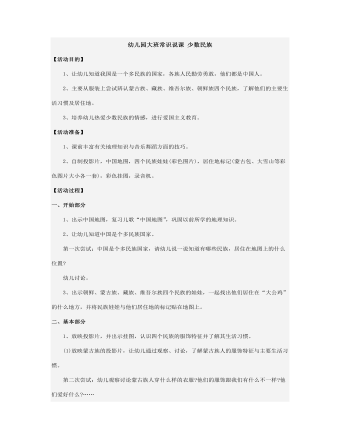
幼儿园大班常识说课 少数民族
开始部分主要是利用幼儿的以往经验,从复习儿歌认识中国地图开始,知道中国是个多民族的国家(重点是让幼儿知道除了汉族外,其他的各个民族都是少数民族。教师用意在使幼儿理解民族大团结),引入本课的具体内容,(请来四个做客的民族娃娃,让幼儿猜一猜他们来自哪里,客人说出自己从哪里来)认识四个民族在地图上的大概位置。这样通过大地图(中国)→许多民族→四位客人。一步步深入到课题,吸引幼儿,激发幼儿学习的欲望。 基本部分是让幼儿认识各民族的服饰特征与生活习惯,通过认识、巩固加深幼儿印象。可以先让幼儿观察幻灯片,由教师的导语让幼儿尝试,进一步仔细观察挂图,在幼儿回答的基础上由教师小结,由此培养幼儿的观察能力与表达能力。然后是复习巩固,通过自制幻灯片的添色游戏,调动幼儿兴趣,快速辨认并参与游戏,这样幼儿既动手参与了游戏、活跃了课堂气氛,又复习了新课。最后为了丰富知识,让幼儿大致了解他们的音乐及舞蹈,这样满足孩子爱唱爱跳的欲望,培养音乐的感受力及欣赏、创编的能力,老师应跳出各民族的舞蹈风格,用情绪与动作感染幼儿,活跃课堂气氛。
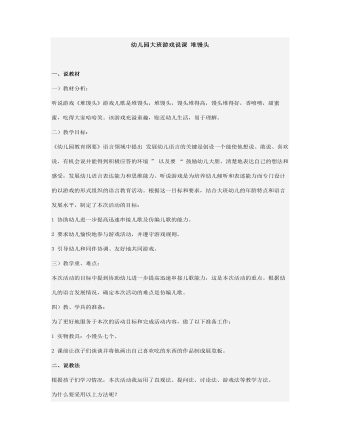
幼儿园大班游戏说课 堆馒头
《幼儿园教育纲要》语言领域中提出 发展幼儿语言的关键是创设一个能使他想说、敢说、喜欢说、有机会说并能得到积极应答的环境 ” 以及要 “ 鼓励幼儿大胆、清楚地表达自己的想法和感受,发展幼儿语言表达能力和思维能力。听说游戏是为培养幼儿倾听和表述能力而专门设计的以游戏的形式组织的语言教育活动。根据这一目标和要求,结合大班幼儿的年龄特点和语言发展水平,制定了本次活动的目标:1 协助幼儿进一步提高迅速串接儿歌及仿编儿歌的能力。2 要求幼儿愉快地参与游戏活动,并遵守游戏规则。3 引导幼儿和同伴协调、友好地共同游戏。
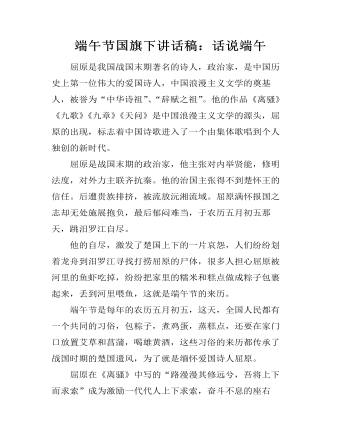
端午节国旗下讲话稿:话说端午
屈原是我国战国末期著名的诗人,政治家,是中国历史上第一位伟大的爱国诗人,中国浪漫主义文学的奠基人,被誉为“中华诗祖”、“辞赋之祖”。他的作品《离骚》《九歌》《九章》《天问》是中国浪漫主义文学的源头,屈原的出现,标志着中国诗歌进入了一个由集体歌唱到个人独创的新时代。屈原是战国末期的政治家,他主张对内举贤能,修明法度,对外力主联齐抗秦。他的治国主张得不到楚怀王的信任。后遭贵族排挤,被流放沅湘流域。屈原满怀报国之志却无处施展抱负,最后郁闷难当,于农历五月初五那天,跳汨罗江自尽。他的自尽,激发了楚国上下的一片哀怨,人们纷纷划着龙舟到汨罗江寻找打捞屈原的尸体,很多人担心屈原被河里的鱼虾吃掉,纷纷把家里的糯米和糕点做成粽子包裹起来,丢到河里喂鱼,这就是端午节的来历。
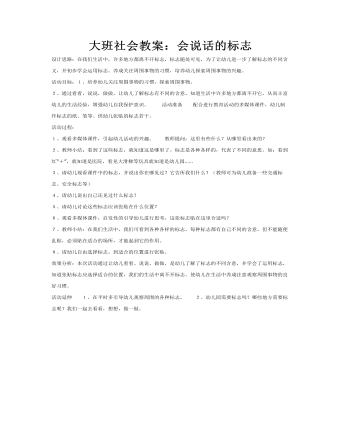
大班社会教案:会说话的标志
2、通过看看,说说,做做,让幼儿了解标志有不同的含意,知道生活中许多地方都离不开它,从而丰富幼儿的生活经验,增强幼儿自我保护意识。 活动准备 配合进行教育活动的多媒体课件,幼儿制作标志的纸、笔等、供幼儿张贴的标志若干。 活动过程:1、观看多媒体课件,引起幼儿活动的兴趣。 教师提问:这里有些什么?从哪里看出来的?2、教师小结:看到了这些标志,就知道这是哪里了。标志是各种各样的,代表了不同的意思。如:看到红“+”,就知道是医院,看见大滑梯等玩具就知道是幼儿园……3、请幼儿观看课件中的标志,并说出你在哪见过?它告所我们什么?(教师可为幼儿准备一些交通标志、安全标志等)
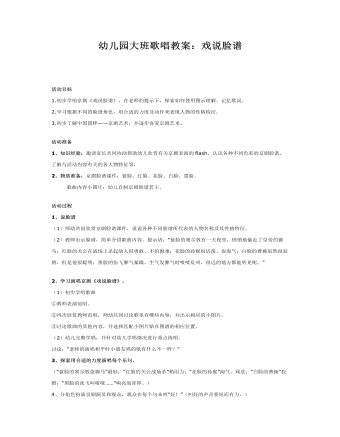
幼儿园大班歌唱教案:戏说脸谱
2.学习根据不同的脸谱角色,用合适的力度及动作来表现人物的性格特征。 3.初步了解中国国粹——京剧艺术,并逐步喜爱京剧艺术。活动准备 1、知识经验:邀请家长共同协助帮助幼儿欣赏有关京剧表演的flash、认识各种不同色彩的京剧脸谱、了解与活动内容有关的各人物特征等, 2、物质准备:京剧脸谱课件:蓝脸、红脸、花脸、白脸、黑脸。 歌曲内容小图片;幼儿自制京剧脸谱若干。 活动过程 1、说脸谱 (1)师幼共同欣赏京剧脸谱课件,说说各种不同脸谱所代表的人物名称及其性格特征。
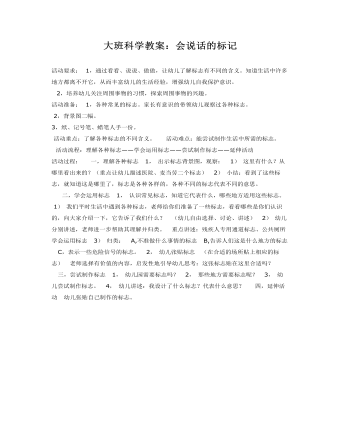
大班科学教案:会说话的标记
2,培养幼儿关注周围事物的习惯,探索周围事物的兴趣。 活动准备; 1,各种常见的标志。家长有意识的带领幼儿观察过各种标志。 2,背景图二幅。 3,纸、记号笔、蜡笔人手一份。 活动重点:了解各种标志的不同含义。 活动难点:能尝试制作生活中所需的标志。 活动流程:理解各种标志——学会运用标志——尝试制作标志——延伸活动 活动过程: 一,理解各种标志 1,出示标志背景图,观察: 1)这里有什么?从哪里看出来的?(重点让幼儿描述医院、麦当劳二个标志) 2)小结:看到了这些标志,就知道这是哪里了,标志是各种各样的,各种不同的标志代表不同的意思。

大班科学教案:会说话的标志
2.培养幼儿关注周围事物的习惯,探索周围事物的兴趣。 活动流程: 理解各种标志-->学会运用标志-->制作生活中所需的标志 材料与环境创设: 标志的背景图 活动指导: 一、理解各种标志(知道什么是标志,了解标志是各种各样的。) 1.这里有些什么?从哪里看出来的?(重点让幼儿描述医院,麦当劳和红星幼儿园三个标志) 2.小结:看到了这些标志,就知道这是哪里了。标志是各种各样的,代表了不同的意思。
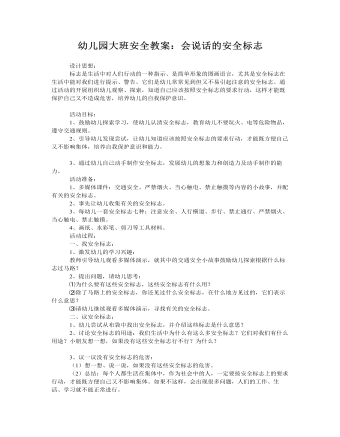
大班安全教案:会说话的安全标志
活动目标: 1、鼓励幼儿探索学习,使幼儿认清安全标志,教育幼儿不要玩火、电等危险物品,遵守交通规则。 2、引导幼儿发现尝试,让幼儿知道应该按照安全标志的要求行动,才能既方便自己又不影响集体,培养自我保护意识和能力。 3、通过幼儿自己动手制作安全标志,发展幼儿的想象力和创造力及动手制作的能力。 活动准备: 1、多媒体课件:交通安全、严禁烟火、当心触电、禁止触摸等内容的小故事,并配有关的安全标志。 2、事先让幼儿收集有关的安全标志。 3、每幼儿一套安全标志七种:注意安全、人行横道、步行、禁止通行、严禁烟火、当心触电、禁止触摸。 4、画纸、水彩笔、剪刀等工具材料。

幼儿园大班亲子教案:我说一,谁对一
活动准备:各种动物的图片 活动建议:家长和孩子面对面坐着,一边拍手,一边说儿歌。 可以有几种形式: 开始的时候,家长说,孩子对 当孩子对儿歌的内容基本了解后,家长与孩子一起说。 当孩子把儿歌的内容都记住了,让孩子说,家长对。 当这首儿歌熟悉后,可以适当改变内容,如哪个爱在水里游,可以回答“鸭子爱在水里游”,也可回答“鱼儿爱在水里游”。
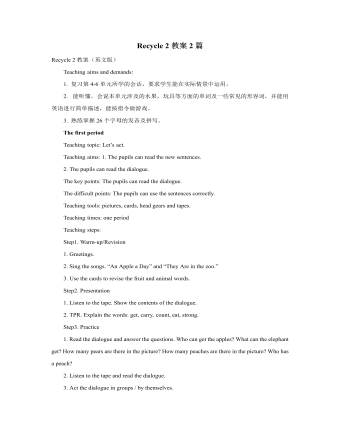
人教版新课标PEP小学英语三年级下册Recycle 2教案2篇
第三课时教学设计方案【教学内容和目标】【教学重点】 制作键盘; 学唱英文歌曲 “A B C Song ”。【教学难点】复习过程中的兴趣培养;【教具准备】1 教材配套的录音带。2 教师和学生分别准备废旧的硬纸盒/纸版、剪刀、胶水。3 教师准备一个自己已制作好的键盘。4 教师准备字母卡片和真正的键盘一个。【教学过程】1 热身、复习 (Warm-up/Revision)(1)师生之间进行英语对话或进行日常口语活动。(2)学生之间自编对话并表演。(3)教师播放B Let’s chant 的录音,让学生边拍手边说歌谣。(4)游戏:Silent Speech教师换一种方法说字母------唇说,说字母的时候不发出声音。学生看教师的口形,猜教师“说”的内容。说的字母为Aa----Zz 。2 呈现新课 (Presentation)(1)教师出示字母卡片,学生认读字母Aa----Zz。(2)学生字母背诵Aa----Zz。(3)教师播放歌曲 “A B C Song ”,告诉学生“试一试”“比一比”,看看谁能通过自己试唱学会歌曲。
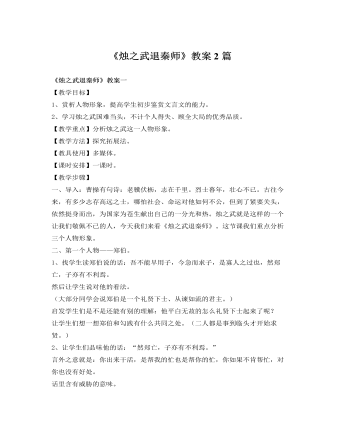
人教版高中语文《烛之武退秦师》教案2篇
【教学目标】1.学习本文精彩的人物语言——说理透辟,善于辞令,以及起伏跌宕,生动活泼的情节。2.掌握文章中出现的古汉语常识,注意多义词在不同语境中的不同意义和用法。3.了解烛之武说服秦伯的方法——善于利用矛盾,采取分化瓦解的方法,认识烛之武机智善辩的外交才能。【教学重点】1.烛之武人物形象的把握。2.波澜起伏,生动活泼的情节。【教学难点】通过学习本课,使学生对《左传》的语言特点有所了解。【教学过程】第一课时课前预习:(1)借助工具书,通读原文。(2)参考有关资料,对《左传》在先秦文学史中的地位及《左传》的语言特色有所了解。(3)初步了解故事情节,特别注意对烛之武这个中心人物的把握。(4)画出自己不理解的问题及难点。

人教版新目标初中英语九年级上册Teenagers should be allowed to choose their own clothes教案2篇
Step 1 Greeting Greet the class and check the homeworkStep 2 A duty report The S on duty gives a report on the rules in his home and lead in 3a “Sun Fei’s and Wu Yu’s rules” Step 3 ReadingSs read the conversation and write the two girls’ rules in the chart. Check the answers.Get Ss to read after the tape and then read aloud by themselves. Then, T explains the language points.Step 4 Pairwork 3bRole play. Use the information in chart to practice with the conversation in 3a covered. They can look at the sample conversation in the right box.Step 5 Task 2 “Who’s the best reporter?”Make a survey by asking any 5 students the questions in the chart in activity 4. Then give out a report about it. See who is the best reporter? And the best reporter will get a nice ball-pen.Step 6 Summary and homework:Write out the report in your exercise-books.Period ThreeStep 1 Greeting and a duty reportThe S gives a duty report talking about his experience of being late for school. Lead in the question “Do you ever get to school late? How often do you get to school late? Always, usually, sometimes, or never?Step 2 1a Get Ss to finish writing.Step 3 Pairwork 1b Get Ss to talk about their answers with their partners using the sample conversation in the box on the right.Step 4 Listening practice2a Lead-in: What will happen if you get to school late? What about Peter? Let’s listen to a conversation between Peter and his father. Get Ss to finish 2a (As usual, for the first time, Ss only listen.) Check the answers.

人教版新目标初中英语九年级上册Where would you like to visit教案2篇
The First PeriodⅠ.Teaching Aims and DemandsKnowledge Objects(1) Key Vocabularytiring, educational, fascinating, thrilling, peaceful, exotic, trek, jungle, take it easy, explore, historic, site(2) Target LanguageWhere would you like to go on vacation?I’d like to trek through the jungle, because I like exciting vacations.2. Ability Objects(1)Train students to talk about places they would like to visit with the target language.(2)Train students to describe vacations with different adjectives.(3)Train students' listening skill.3. Moral Object,It′s more interesting to go on vacating somewhere instead of staying at home.Ⅱ. Teaching Key Points1. Key Vocabularytiring, educational, fascinating, thrilling, peaceful, exotic, trek, jungle, take it easy, explore, historic, site2. Target LanguageTalk about different places with the target language.Ⅲ. Teaching Difficult Points1. Describe vacations with different adjectives.2. Talk about different places with the target language.Ⅳ. Teaching Methods1. Teaching by illumination2. Teaching by doing chain drills3. Teaching by pairworkⅤ. Teaching Aids1. A tape recorder2. Some pictures of different places with famous views

人教版新目标初中英语七年级下册How was your weekend教案2篇
Teaching Goal:1. General aims:Talk about recent past events2. Particular aims:A. Language Focus.Talk about recent past events and think of the past events.B. Language goalsHow was….?It was …What did …do over the weekend?C. Language structures:(1). How was your weekend? I was great. Pay attention to no form.(2). What did you do over the weekend? I played soccer. We went to the beach.D. Useful words and phrases:Words: was, did, went, beach, over, project, test, wasn’t, false, number, geography, spend, week, most, mixture, their, had, little, cook, read, saw, change, everyone, sit, sat, no, anythingPhrases: did one’s homework, played soccer, cleaned my room, went to the beach, played tennis, went to the movies, on Saturday morning, over the weekend, cook … for, what about, do some reading, have a party, talk show, go shoppingE. Grammar language:Present simple past tenseRegular and irregular verbsF. Learning strategies:Tour and holidaysG. Interdiscipinary:H. Emotion and manner:Teaching time: 5 periodsTeaching procedures:Period One教学步骤、时间 教师活动 学生活动 媒体应用Step 1Free talk 3’ Ask some questions like:Who’s on duty today?What’s the weather like? Answer and talk about something.让同学们回答下列问题1. Do you like weekend? (Let some students answer)It takes them three minutes to talk about the question.2. Why do you like weekend? (let the students answer) Most of the students like the weekend此时教师用汉语问:“在周末期间问你干了什么?这句话用英语这么回答?Let the students guess.At last the teacher give them right answer3. What did you do over the weekend?(板书、学习)

人教版新目标初中英语七年级下册Don’t eat in class教案2篇
Don’t fight. =You can’t fight. (板书,教读)教师把这些句子板书在黑板上,并请学生大声整齐地读祈使句和“can’t”句型,并让学生注意两种句型表达形式的不同和转换,“Don’t …=You can’t…”;并对学生说:These are our school rules. (板书,教读) You can’t break the school rules. Don’t break the school rules.(板书,教读)步骤3 :Practicea. T: Now, each of the students is breaking one of these rules.Please finish 1a.学生看图,完成1a的内容,检查答案并大声朗读校规。b. 听录音,完成1b,选出四位学生都违反了哪条校规;听之前,学生要读会英文名。c. 请两位学生朗读1c部分的句型;要求学生两人一组对话表演,SA扮演外校转来新生,SB告知本校校规。(学生可经过讨论,多说出他们想到的校规,不必只限于书上;教师应给予帮助)2) 第二课时(2a~4)步骤1 :warming up of revisionT: What are the rules at your school?学生使用“can”或祈使句表达各条校规;其中老师可引出“eat in the cafeteria outside”的表达。步骤2 :Practicea.T: Christina is an exchange student. She doesn’t know the rules. Let’s listen, what activities they’re talking about?学生听第一遍时,完成2a;第二遍时,完成2b;b. 请学生领读2c部分,看着2a完成的表格,理解2c活动的要求;分成小组针对2a进行问答;

